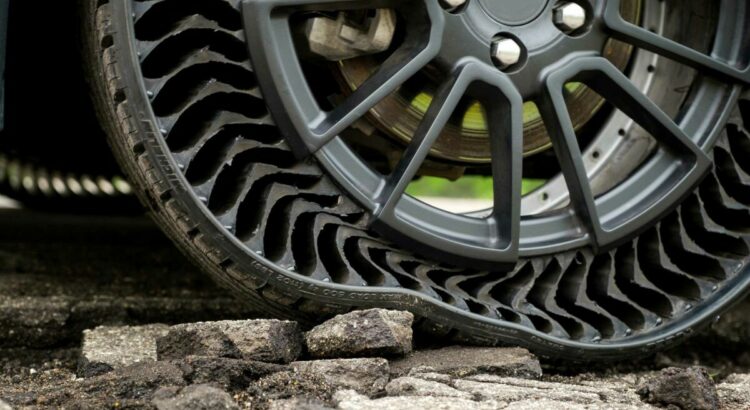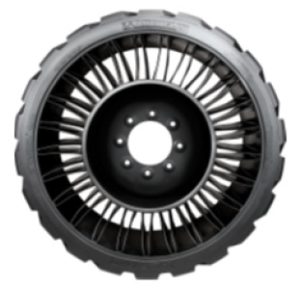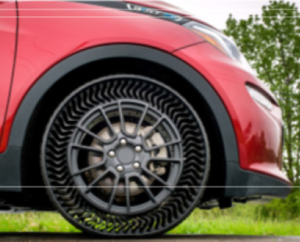
A brief history of the airless tire
The first pneumatic (or air-inflated) tires were invented in the 19th century. The very basic idea is to use compressed air contained in a toroid or torus as a cushion between the vehicle and the road pavement and to let the solid materials in the outer part of this toroid or torus transfer the forces in both transverse and longitudinal directions between the axle and the pavement. To this end, a rubber tread is added around the torus.
Today, the tires we currently used are based on the radial tires, developed by Michelin in 1946 (see the video below, in French, English subtitles available):
Although this concept was improved and refined over the years for multiple uses, it poses several problems:
- Compressed air is still the core of modern tires. They are then sensible to any cracks and holes that could leak air.
- The air pressure inside the tires will vary according to time, temperature, altitude, … Thus, the air pressure might not be ideal at all time, increasing the speed at which a tire wears and releases more microparticles in the air as well as being louder.
- The inflated rubber acts like an acoustic resonator and thus increase the rolling noise generated by the tires.
- A pneumatic tire is completely replaced when used, generating high amount of waste.
- Making a pneumatic uses more than 100 components, with the major part being synthetic rubber and other include carbon black, various oils, sulfur, … Thus, making tires is environmentally costly, especially the synthetic rubber.
Some prototypes were designed to solve those problems but they never passed the state of experimental prototypes, until the airless tire. The concept is simple, the goal is to replace the center of the tire – the air-inflated rubber – by a composite material, highly flexible, so that it could withstand the weight of the vehicle while transfering the force between the axle and the pavement more efficiently. Being airless, those tires cannot be flat and would have a much higher lifespan.
The concept originated from two independent sources. Goodyear designed the Integral Wheel Tire (IWT) for passenger cars in 1982, based on a single-sided wheel. In 1990, the Swedish inventor Mr. Hans-Erik Hansson was granted a patent for the “Composite Wheel”: another a non-pneumatic wheel with highly flexible construction in composite materials giving unique characteristics. Relative to the Goodyear design it used a more sophisticated shape, potentially giving it much more flexibility in the design. The rim was integrated with the tire, using a composite material of glass-fiber/polyester laminate. Several tests conducted by VTI (Swedish National Road and Transport Research Institute, see the photo of the test below) showed that this design already reduced the generated noise by 10 dB(A) compared to a popular tire at the time (Goodyear Eagle NCT70)).

Although revolutionary, the airless designs needed some improvement to reach the market. It became popular for manufacturer to display such concepts in automotive shows. In 2005, Michelin presented the Tweel (Tire-WHEEL, see image below). Tweel consists of a composite reinforced tread band, connected to a flexible (deformable) wheel via rectangular, polyurethane spokes. The resulting mechanical structure provides weight-carrying ability, shock absorption, ride comfort, rolling resistance and mass similar to pneumatic tires while adding suspension-like characteristics that greatly improve handling.

However, it never made it to the road market and instead it is now used on industrial trucks and some other off-road vehicles. Some other concepts were designed by Michelin (Vision concept), Bridgestone, Goodyear (Aero concept), Hankook (iFlex concept). They mainly aimed at improving the load they could carry and being made with more eco-friendly materials. In Iran, Barez Tires, produced and seemed to commercialize three versions of airless tires to reduce the percentage of imported materials to make the tires. Michelin is one of the major fabricants that seems to push the airless tire for the road market. They want to introduce their second version of the Uptis (Unique Puncture-Proof Tire System, photo below) tire on the road market starting 2024 and already started public testing and advertisement. The airless tire will then hit the market soon and might be the tire of the future!

The information and photos in this post come from the following article, licensed under the under Creative Commons Attribution 4.0 License and are published with the permission of the original author:
Ulf Sandberg. The Airless Tire: Will this Revolutionary Concept be the Tire of the Future?. Mod Concept Material Sci. 3(3): 2020. MCMS. MS.ID.000563. DOI: 10.33552/MCMS.2020.03.000563
